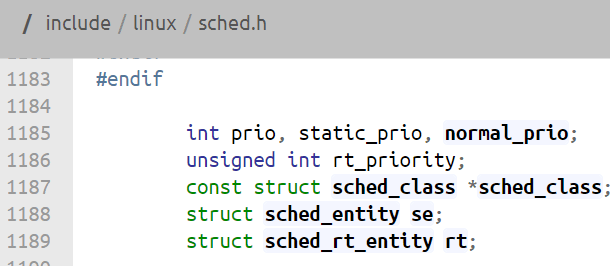Linux内核学习014——进程调度(三)
Linux调度算法
在Linux中,调度器是以模块方式提供的,这样可以允许不同类型的进程有针对性地选择调度算法。这种模块化结构称为调度器类,其允许多种不同的可动态添加的调度算法并存,调度属于自己范畴的进程。每个调度器有一个优先级,基础调度器会依优先级遍历调度类,拥有最高优先级的调度器类选择将要执行的程序。
CFS就是一个调度器类,在Linux中称为SCHED_NORMAL,其具体定义在Linux2.6.34/kernel/sched_fair.c中。
CFS的理念很简单:进程调度的效果应如同系统具备一个理想中的完美多任务处理器。即每个进程可获得1/n的处理器时间(n为可运行的进程数量)。但是,由于调度时进程抢占的开销,比如:进程换入、进程换出、缓存影响等,理想模型是无法实现的。因此,CFS充分考虑了额外开销,确保了系统性能不受影响。CFS的做法是:允许每个进程运行一段时间,循环轮转,选择运行最少的进程作为下一个运行进程,而不是分配每个进程以时间片。nice值在CFS中被作为进程获得处理器运行比得权重(高nice值,低优先级,低处理器使用权重)。当可运行进程数量过多时,它们各自所获得的处理器使用比和时间片都趋于0,CFS为此设立了最小粒度,默认值为1ms。
总结:任何进程所获得的处理器时间是由它自己和其他所有可运行进程nice值的相对比例决定的。
Linux调度的实现
CFS具体实现位于kernel/schde_fair.c,其中需要重点关注的是四个组成部分:
- 时间记账
- 进程选择
- 调度器入口
- 睡眠和唤醒
时间记账
显然,所有的调度器都必须记录进程的运行时间。CFS中使用一个结构体sched_entity来记录进程运行信息,其定义在Linux2.6.34/include/linux/sched.h#L1090:
/*
* CFS stats for a schedulable entity (task, task-group etc)
*
* Current field usage histogram:
*
* 4 se->block_start
* 4 se->run_node
* 4 se->sleep_start
* 6 se->load.weight
*/
struct sched_entity {
struct load_weight load; /* for load-balancing */
struct rb_node run_node;
struct list_head group_node;
unsigned int on_rq;
u64 exec_start;
u64 sum_exec_runtime;
u64 vruntime;
u64 prev_sum_exec_runtime;
u64 last_wakeup;
u64 avg_overlap;
u64 nr_migrations;
u64 start_runtime;
u64 avg_wakeup;
#ifdef CONFIG_SCHEDSTATS
u64 wait_start;
u64 wait_max;
u64 wait_count;
u64 wait_sum;
u64 iowait_count;
u64 iowait_sum;
u64 sleep_start;
u64 sleep_max;
s64 sum_sleep_runtime;
u64 block_start;
u64 block_max;
u64 exec_max;
u64 slice_max;
u64 nr_migrations_cold;
u64 nr_failed_migrations_affine;
u64 nr_failed_migrations_running;
u64 nr_failed_migrations_hot;
u64 nr_forced_migrations;
u64 nr_wakeups;
u64 nr_wakeups_sync;
u64 nr_wakeups_migrate;
u64 nr_wakeups_local;
u64 nr_wakeups_remote;
u64 nr_wakeups_affine;
u64 nr_wakeups_affine_attempts;
u64 nr_wakeups_passive;
u64 nr_wakeups_idle;
#endif
#ifdef CONFIG_FAIR_GROUP_SCHED
struct sched_entity *parent;
/* rq on which this entity is (to be) queued: */
struct cfs_rq *cfs_rq;
/* rq "owned" by this entity/group: */
struct cfs_rq *my_q;
#endif
};
下半部分的成员变量需要设置了CONFIG_SCHEDSTATS和CONFIG_FAIR_GROUP_SCHED时才会启用,重点关注前半部分即可。
调度器实体结构是作为一个名为se的成员变量,嵌入在进程描述符struct task_struct中的。
虚拟实时
sched_entity中的u64 vruntime成员记录进程的虚拟运行时间,单位为ns。CFS使用vruntime变量来记录一个程序运行了多久以及还能运行多久,定义在Linux2.6.34/kernel/sched_fair.c#L518的函数update_curr实现了该记账功能:
static void update_curr(struct cfs_rq *cfs_rq)
{
struct sched_entity *curr = cfs_rq->curr;
u64 now = rq_of(cfs_rq)->clock;
unsigned long delta_exec;
if (unlikely(!curr))
return;
/*
* Get the amount of time the current task was running
* since the last time we changed load (this cannot
* overflow on 32 bits):
*/
delta_exec = (unsigned long)(now - curr->exec_start);
if (!delta_exec)
return;
__update_curr(cfs_rq, curr, delta_exec);
curr->exec_start = now;
if (entity_is_task(curr)) {
struct task_struct *curtask = task_of(curr);
trace_sched_stat_runtime(curtask, delta_exec, curr->vruntime);
cpuacct_charge(curtask, delta_exec);
account_group_exec_runtime(curtask, delta_exec);
}
}
update_curr()计算了当前进程的执行时间,并将其存放在变量delta_exec总,然后将与运行时间传递给__update_curr(),由其根据当前可运行进程总数对运行时间进行加权计算,最终将权重值与当前进程的vruntime相加。
注:__update_curr()函数定义在update_curr()函数上方
/*
* Update the current task's runtime statistics. Skip current tasks that
* are not in our scheduling class.
*/
static inline void
__update_curr(struct cfs_rq *cfs_rq, struct sched_entity *curr,
unsigned long delta_exec)
{
unsigned long delta_exec_weighted;
schedstat_set(curr->exec_max, max((u64)delta_exec, curr->exec_max));
curr->sum_exec_runtime += delta_exec;
schedstat_add(cfs_rq, exec_clock, delta_exec);
delta_exec_weighted = calc_delta_fair(delta_exec, curr);
curr->vruntime += delta_exec_weighted;
update_min_vruntime(cfs_rq);
}
update_curr()是由系统定时器周期性调用的,因此vruntime可以准确地测量给定进程的运行时间,且可以知道下一额运行的进程。
进程选择
CFS需要选择下一个进程运行时,它会挑选一个具有最小vruntime的进程。CFS使用了红黑树来组织可运行进程队列,关于红黑树可以参考这篇文章。红黑树是一个自平衡二叉搜索树,以树节点形式存储数据,这些数据对应一个键值,可通过键值快速检索节点上的数据。
假设存在一个红黑树存储了系统中所有的可运行进程,其中的节点键值为可运行进程的虚拟运行时间。CFS选择vruntime最小的,即树中最左侧的叶子节点,可以从树的根节点一直沿左侧子节点向下找直到叶子节点。实现该过程的函数为__pick_next_entity(),其定义在Linux2.6.34/source/kernel/sched_fair.c#L377。
static struct sched_entity *__pick_next_entity(struct cfs_rq *cfs_rq)
{
struct rb_node *left = cfs_rq->rb_leftmost;
if (!left)
return NULL;
return rb_entry(left, struct sched_entity, run_node);
}
注:其实__pick_next_entity()函数本身并不会遍历树找到最左子节点,因为该值已经缓存在rb_leftmost中了。
加入进程
CFS先rbtree(红黑树)中加入可执行进程发生在进程变为可执行状态或者是通过fork()调用第一次创建进程是,enqueue_entity()函数实现了该过程:
static void
enqueue_entity(struct cfs_rq *cfs_rq, struct sched_entity *se, int flags)
{
/*
* Update the normalized vruntime before updating min_vruntime
* through callig update_curr().
*/
if (!(flags & ENQUEUE_WAKEUP) || (flags & ENQUEUE_MIGRATE))
se->vruntime += cfs_rq->min_vruntime;
/*
* Update run-time statistics of the 'current'.
*/
update_curr(cfs_rq);
account_entity_enqueue(cfs_rq, se);
if (flags & ENQUEUE_WAKEUP) {
place_entity(cfs_rq, se, 0);
enqueue_sleeper(cfs_rq, se);
}
update_stats_enqueue(cfs_rq, se);
check_spread(cfs_rq, se);
if (se != cfs_rq->curr)
__enqueue_entity(cfs_rq, se);
}
该函数更新运行时间和其他一些统计数据,然后调用__enqueue_entity()进行插入操作:
/*
* Enqueue an entity into the rb-tree:
*/
static void __enqueue_entity(struct cfs_rq *cfs_rq, struct sched_entity *se)
{
struct rb_node **link = &cfs_rq->tasks_timeline.rb_node;
struct rb_node *parent = NULL;
struct sched_entity *entry;
s64 key = entity_key(cfs_rq, se);
int leftmost = 1;
/*
* Find the right place in the rbtree:
*/
while (*link) {
parent = *link;
entry = rb_entry(parent, struct sched_entity, run_node);
/*
* We dont care about collisions. Nodes with
* the same key stay together.
*/
if (key < entity_key(cfs_rq, entry)) {
link = &parent->rb_left;
} else {
link = &parent->rb_right;
leftmost = 0;
}
}
/*
* Maintain a cache of leftmost tree entries (it is frequently
* used):
*/
if (leftmost)
cfs_rq->rb_leftmost = &se->run_node;
rb_link_node(&se->run_node, parent, link);
rb_insert_color(&se->run_node, &cfs_rq->tasks_timeline);
}
删除进程
删除进程发生在进程堵塞或者终止时:
static void
dequeue_entity(struct cfs_rq *cfs_rq, struct sched_entity *se, int sleep)
{
/*
* Update run-time statistics of the 'current'.
*/
update_curr(cfs_rq);
update_stats_dequeue(cfs_rq, se);
if (sleep) {
#ifdef CONFIG_SCHEDSTATS
if (entity_is_task(se)) {
struct task_struct *tsk = task_of(se);
if (tsk->state & TASK_INTERRUPTIBLE)
se->sleep_start = rq_of(cfs_rq)->clock;
if (tsk->state & TASK_UNINTERRUPTIBLE)
se->block_start = rq_of(cfs_rq)->clock;
}
#endif
}
clear_buddies(cfs_rq, se);
if (se != cfs_rq->curr)
__dequeue_entity(cfs_rq, se);
account_entity_dequeue(cfs_rq, se);
update_min_vruntime(cfs_rq);
/*
* Normalize the entity after updating the min_vruntime because the
* update can refer to the ->curr item and we need to reflect this
* movement in our normalized position.
*/
if (!sleep)
se->vruntime -= cfs_rq->min_vruntime;
}
实际删除工作由__dequeue_entity()完成。
static void __dequeue_entity(struct cfs_rq *cfs_rq, struct sched_entity *se)
{
if (cfs_rq->rb_leftmost == &se->run_node) {
struct rb_node *next_node;
next_node = rb_next(&se->run_node);
cfs_rq->rb_leftmost = next_node;
}
rb_erase(&se->run_node, &cfs_rq->tasks_timeline);
}
调度器入口
调度器入口时函数schedule(),该函数定义在Linux2.6.34/kernel/sched.c#L3698中。schedule()时内恶化其他部分调用进程调度器的入口,其通常和一个具体的调度类相关联。
/*
* schedule() is the main scheduler function.
*/
asmlinkage void __sched schedule(void)
{
struct task_struct *prev, *next;
unsigned long *switch_count;
struct rq *rq;
int cpu;
need_resched:
preempt_disable();
cpu = smp_processor_id();
rq = cpu_rq(cpu);
rcu_sched_qs(cpu);
prev = rq->curr;
switch_count = &prev->nivcsw;
release_kernel_lock(prev);
need_resched_nonpreemptible:
schedule_debug(prev);
if (sched_feat(HRTICK))
hrtick_clear(rq);
raw_spin_lock_irq(&rq->lock);
update_rq_clock(rq);
clear_tsk_need_resched(prev);
if (prev->state && !(preempt_count() & PREEMPT_ACTIVE)) {
if (unlikely(signal_pending_state(prev->state, prev)))
prev->state = TASK_RUNNING;
else
deactivate_task(rq, prev, 1);
switch_count = &prev->nvcsw;
}
pre_schedule(rq, prev);
if (unlikely(!rq->nr_running))
idle_balance(cpu, rq);
put_prev_task(rq, prev);
next = pick_next_task(rq);
if (likely(prev != next)) {
sched_info_switch(prev, next);
perf_event_task_sched_out(prev, next);
rq->nr_switches++;
rq->curr = next;
++*switch_count;
context_switch(rq, prev, next); /* unlocks the rq */
/*
* the context switch might have flipped the stack from under
* us, hence refresh the local variables.
*/
cpu = smp_processor_id();
rq = cpu_rq(cpu);
} else
raw_spin_unlock_irq(&rq->lock);
post_schedule(rq);
if (unlikely(reacquire_kernel_lock(current) < 0)) {
prev = rq->curr;
switch_count = &prev->nivcsw;
goto need_resched_nonpreemptible;
}
preempt_enable_no_resched();
if (need_resched())
goto need_resched;
}
睡眠和唤醒
睡眠(被阻塞)的进程无法执行,原因是其在等待一些时间发生,比如:文件I/O,网络请求等。休眠中的进程有两个相关的进程状态:TASK_INTERRUPTIBLE和TASK_UNINTERRUPTIBLE。区别在于处于TASK_UNINTERRUPTIBLE的进程会忽略信号,而处于TASK_INTERRUPTIBLE的进程会被信号唤醒并响应信号。此外,两种状态的进程都位于一个等待队列上等待事件发生,不能运行。
唤醒
唤醒通过wake_up()函数完成,它会唤醒指定的等待队列上的所有进程。
